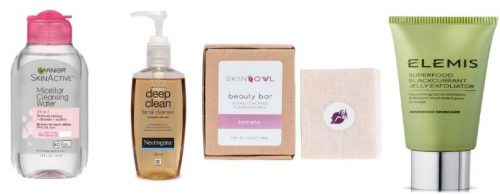I am shifting gears to focus on facial cleansers. I’ll cover everything from micellar water to double cleansing and more. Today’s blog is laying out the absolute basics of what a facial cleanser does. Before that, let’s be crystal clear.
Everyone should be using a cleanser. Water simply will not cut it. You need a cleanser to remove dirt (make-up, especially water-resistant make-up, particle pollution), sebum (naturally occurring oil on your face) and dead cells.

1) How does a facial cleanser/ wash work?
Cleansers, whether it’s dog shampoo or make-up remover, pretty much operate on the same principle. Cleansers contain surface active agents or SURFACTANTS and these are designed to remove dirt, sebum, oil from cosmetic products, microorganisms as well as dead cells.
If your skin was as unreactive as a marble kitchen top, we probably wouldn’t be having this conversation – but the top layer of our skin (stratum corneum) is made up of mainly protein and lipids, which react with surfactants.
2) What do we want a facial cleanser to do?
Obviously, we want the facial cleanser to clean and in addition, it should do this without damaging or irritating the skin. It should also try to keep the skin surface moist. As you will see in my future product reviews, this is a tall order.
3) How do I choose a cleanser?
You have probably been choosing a facial cleanser based on your skin type – that’s generally correct. If you have oily, dry or combination skin, the labelling on your product is a good starting point.
If you don’t know what your skin type is, then please read this post What is my skin type?
When choosing a cleanser, you also should take into account the following:
- Is your skin photo damaged?
- E.g., is it prone to hyper-pigmentation, suffering from loss of collagen?
- I have normal skin, but it is photo-damaged. If I use normal cleansers, then the surfactants are harsh, damaging mainly my already damaged protein structure….Because of my age and compromised skin, I need a mild cleanser.
- Age
- You want mild surfactants and if possible, those that add moisturising agents back to your skin
- Sensitive skin
- Honestly, everyone in my family, bar my cousin brother thinks they have sensitive skin. Again, mild surfactants are the answer.
If you have a dermatological disorders such as acne, rosacea or dermatitis then you should use a dermatologist recommended cleanser.
My blog posts can tell you ingredients / cleansers to avoid, but I can’t tell you what to use. Mainly because I have never suffered from any of these conditions and it would be dishonest if I pretended to know the pain and agony that women of all ages suffer from (e.g., cystic acne). I don’t.
Finally…
Consumers (and manufacturers) prefer liquid cleansers and that’s what I’ll be focussing on.
P.S. Skincare Nerd alert
For those of you who are happy to rely on my recommendations, please stop reading now. For my tribe of nerds please continue reading.

What’s the science behind cleansers?
Everyone (by which I mean manufacturers and scientists, and not Zachary Levi or Keanu Reeves) agree on a few things:
1) Harsh surfactants in cleansers cause damage to BOTH skin proteins and lipids.
Surfactants can’t tell the difference between the NATURAL constituents of your skin (protein and lipids) AND what its trying to remove (dirt, oil, dead cells).
2) The same surfactant will affect proteins and lipids differently.
Harsh surfactants will affect PROTEINS more than lipids. Damage to to skin proteins and lipids, leads to after‐wash tightness, dryness, barrier damage, irritation, and even itch.
3) Consumers, especially Asian consumers like the lather /foam effect of cleansers.
Which I totally get – two minutes on the Delhi metro is enough to want to scrub your skin off. The lather/foam effect of cleansers is achieved via harsh surfactants.
FUN FACT: when using low-foaming cleansers, consumers over-compensate by using MORE product because they think their skin is not clean. Hence, starts the process of damage to skin.
4) Surfactants, like the British class system, are not born equal.
There is a scale of mild to harsh surfactants. As a general rule, we are looking for mild surfactants. I will highlight mild surfactants in product reviews.
5) Anatomy of a facial cleanser
I thought it would be fun to actually show you what an actual product looks like, but its actually horrifying (even for me), so I’ll bench that for another day, perhaps closer to Halloween.
FUN FACT: Most cleansers will contain some or all of the following:
| Water | Surfactant | Moisturising agent | Binder / Stabiliser |
| Lather Enhancer | Preservative | Fragrance | Colour |
Are there any ingredients I should avoid?
Now, given you wash off the cleanser, is there really any merit in avoiding products based on some ingredients?
There is, mainly because if you are anything like me, you wash your face at least 3 times a day if not more. (Morning, after gym and evening). That’s over a thousand times a year and more if I count double cleansing.
Also, if your skin barrier is even moderately damaged, then that will cause ingredients to seep through your skin. Parabens and Benzophenone in products don’t make allowances for damaged skin barriers – they are still going to seep through.
In my product reviews, I will identify ingredients that you should avoid.
Photo by Markus Spiske temporausch.com from Pexels
